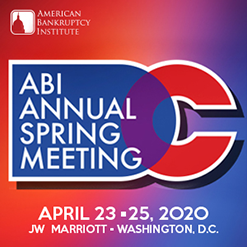| NEWS AND ANALYSIS |
Stores that Stocked Up on Debt Face a Harsh Holiday Reckoning
Retailers are strapping in for the final days of their traditional do-or-die holiday shopping period. For some, that could be meant literally, as creditors and vendors decide which ones are still worth supporting in a field plagued by fewer shoppers, more online competition and too much debt, Bloomberg News reported. Some of the most familiar names — Forever 21 Inc., Barneys New York Inc. and Payless Inc. — have already collapsed into bankruptcy or liquidated this year. Among the survivors, fates have diverged, according to the restructuring experts at FTI Consulting Inc. “The retail sector is becoming more segmented between winners and losers,” Christa Hart, a senior managing director in FTI’s retail and consumer practice, said in an interview. “The ‘average’ has disappeared.” Merchants could use a strong finish after last year’s holiday season, when retailers wound up with their worst sales drop for December since 2008, according to U.S. Census Bureau data analyzed by FTI. This holiday season “will be disproportionately great for the strong players and disproportionately weak for the other ones,” Hart said. Some of the most vulnerable are the traditional department store chains. Moody’s Investors Service predicted in a November report that by the end of 2019, those retailers will have seen their operating income fall by more than 15 percent, despite heavy investing to improve inventory efficiency and to build their online capabilities. “It’s not 1985 anymore,” said Perry Mandarino, head of restructuring and co-head of investment banking at B. Riley FBR Inc. “People don’t need a one-stop shop where they can get everything from vacuum cleaners to jewelry.”


|
|
Commentary: Trump’s New Plan to Make Student Loans Great Again
Student loan debt is the second-highest category of consumer debt after mortgages, averaging about $30,000 per borrower, according to a Forbes commentary. As first reported by the Wall Street Journal, President Trump has been meeting with advisers from the White House and U.S. Department of Education, led by Betsy DeVos, to create a plan to address student loans. During the 2016 presidential campaign, Trump proposed combining the existing student loan repayment plans into a single simpler repayment plan to help borrowers pay off student loans faster. Trump also proposed an income-based repayment plan that would cap monthly student loan payments at 12.5 percent of discretionary income and forgive remaining balances after 15 years. While Trump’s proposal raises the monthly payment cap from 10 percent to 12.5 percent of income, his proposal would forgive the remaining student loan balance five to 10 years sooner than the current income-driven repayment plans. Read the full commentary.

Student loan debt and bankruptcy was the first issue addressed by ABI’s Commission on Consumer Bankruptcy. To view the Commission’s recommendations on student loan debt and bankruptcy, please click here.
Be sure to also read “Game of Loans: Is Student Debt Forgiveness Coming?” in the December edition of the ABI Journal.
Also, the cost of rising tuition was a focus of an ABI Talk at the 2019 Winter Leadership Conference. Click here to watch the presentation by Inez Stepman of the Independent Women’s Forum (Washington, D.C.).

|
|
Survey: Private Capital Aimed at Distressed Businesses in 2020
With a majority of venture capital and private-equity firms expecting a recession to hit within two years, a massive volume of “dry powder” may be targeted at distressed businesses in 2020, CFO.com reported. In a survey of 100 VC fund managers and 100 PE fund managers by BDO, 40 percent and 39 percent of them, respectively, said they expected such businesses to be a “key driver” of deals next year. That represented an enormous departure from BDO’s previous survey of such investors a year ago, when only 1 percent of PE respondents anticipated distressed businesses being a key investment driver in 2019. BDO acknowledged that the current availability of distressed opportunities is “quite low.” However, the professional services firm noted, during the Great Recession private capital flocked to distressed-debt funds, which typically outperform other private investment strategies during an economic downturn. In the survey, 72 percent of private-equity respondents and 56 percent of venture capital respondents said they expected an economic downturn to arrive within two years. And 92 percent and 87 percent of them, respectively, anticipated a downturn within four years, which BDO characterized as “less than the length of most investment holding periods.”

|
|
Analysis: Congress Saves Coal Miner Pensions, but What About Others?
The $1.4 trillion spending bill passed by Congress last week quietly achieves what a parade of select committees and coordinating councils could not: the rescue of a dying pension fund that is the lifeblood of nearly 100,000 retired coal miners, the New York Times reported. For the first time in 45 years of federal pension law, taxpayer dollars will be used to bail out a fund for workers in the private sector. And now that there’s a precedent, it might not be the last. One coal company after another has gone bankrupt and stopped paying into the miners’ pension plan, but the retirees are still there. Its assets are dwindling, but the liabilities have stayed about the same. When the mine workers’ retiree health plan ran out of money in 1989, Congress arranged for new funding sources, including the Abandoned Mine Lands Reclamation Fund and, later, the Treasury. That precedent is now being followed for the miners’ pensions. Starting next year, the Treasury’s transfers to the Abandoned Mine Lands fund will rise to a maximum $750 million a year, and will help pay for pensions as well as retiree health care. This may prompt other unions to seek federal assistance for their plans, too.

|
|
Fed’s U-Turn on Assets Faces a Year-End Test
The Federal Reserve over the last three months has flooded money markets with hundreds of billions of dollars in cash to avoid a repeat of the volatility that roiled cash markets in September, the Wall Street Journal reported. The success of the moves — which reversed roughly half of the Fed’s shrinkage of its asset portfolio over the prior two years — will encounter a test around Dec. 31. That is when some financial institutions could face incentives from regulations to limit their lending, which could cause supply and demand imbalances for cash. Fed officials have said they believe reserves held at the Fed grew scarce enough in mid-September to put pressure on an obscure but important lending rate in the market for repos. “You can flood the markets with reserves, but are the reserves going to be redistributed to the corners of the markets that need it? That’s the big question,” said Ward McCarthy, chief financial economist at financial-services company Jefferies LLC. To prevent a squeeze from happening again, Fed officials have been buying short-term Treasury bills from financial institutions to put more reserves back into the financial system. They also have conducted daily injections of liquidity into markets. Altogether, those operations could add nearly $500 billion in net liquidity to markets around Dec. 31. (Subscription required.)

|
|
The Financial Lesson of 2008-09 that Most Investors Have Forgotten
If 2000-2009 was the Lost Decade for investors, 2010-2019 was the Decade of Forgetting, according to the Wall Street Journal. At year-end 2009, most investors — individuals and professionals alike — expected interest rates to rise, inflation to return, the dollar to weaken, commodities to boom and U.S. stocks to struggle. The giant investment firm Pacific Investment Management Co. and its then-influential co-founder Bill Gross were actively promoting their scenario of “the new normal,” which they described as “likely to be a significantly lower-returning world” for stocks and bonds alike for years to come. (Gross left Pimco in 2014 and retired from money management earlier this year.) Instead, over the ensuing 10 years, interest rates fell to historic lows, inflation all but vanished, the dollar strengthened, commodities languished, and U.S. stocks earned among the highest returns they have produced in any decade. Investors en masse pulled money out of active funds run by people trying to pick the best stocks or bonds, and poured cash into passive funds run by computers holding everything in a market index. Over the decade, according to Morningstar, investors withdrew more than $160 billion from all active funds combined, while adding more than $3.76 trillion to index funds. (Subscription required.)

|
|
Crisis Looms in Antibiotics as Drug Makers Go Bankrupt
At a time when germs are growing more resistant to common antibiotics, many companies that are developing new versions of the drugs are hemorrhaging money and going out of business, gravely undermining efforts to contain the spread of deadly, drug-resistant bacteria, the New York Times reported. Antibiotic start-ups like Achaogen and Aradigm have gone belly up in recent months, pharmaceutical behemoths like Novartis and Allergan have abandoned the sector, and many of the remaining American antibiotic companies are teetering toward insolvency. One of the biggest developers of antibiotics, Melinta Therapeutics, recently warned regulators it was running out of cash. Experts say the grim financial outlook for the few companies still committed to antibiotic research is driving away investors and threatening to strangle the development of new lifesaving drugs at a time when they are urgently needed. The problem is straightforward: The companies that have invested billions to develop the drugs have not found a way to make money selling them. Most antibiotics are prescribed for just days or weeks — unlike medicines for chronic conditions like diabetes or rheumatoid arthritis that have been blockbusters — and many hospitals have been unwilling to pay high prices for the new therapies. Political gridlock in Congress has thwarted legislative efforts to address the problem. The challenges facing antibiotic makers come at a time when many of the drugs designed to vanquish infections are becoming ineffective against bacteria and fungi, as overuse of the decades-old drugs has spurred them to develop defenses against the medicines.

|
|
U.S. Consumer Comfort Hits Nine-Week High on Economic Optimism
Confidence among U.S. consumers advanced to a nine-week high on greater optimism about the economy and brighter views of personal finances and the buying climate, Bloomberg News reported. Bloomberg’s index of consumer comfort increased to 62.3 in the week ended Dec. 22 from 61.1, according to data released today. A measure of confidence in the economy climbed to the highest since the end of July, while the personal finances gauge also was the strongest in nine weeks. Record stock prices, unemployment at a five-decade low and steady wage gains continue to lift spirits, putting the 2019 average sentiment level on track for the best since the 1999-2000 dot-com boom. Combined with elevated sentiment, this backdrop helps explain the economy’s resilience in the face of business-investment cutbacks and global demand concerns.

|
|
Sign up Today to Receive Rochelle’s Daily Wire by E-mail!
Have you signed up for Rochelle’s Daily Wire in the ABI Newsroom? Receive Bill Rochelle’s exclusive perspectives and analyses of important case decisions via e-mail!
Tap into Rochelle’s Daily Wire via the ABI Newsroom and Twitter!
|
|
|
|
| BLOG EXCHANGE |
|
New on ABI’s Bankruptcy Blog Exchange: 600,000 Student Loan Borrowers Getting Nowhere
Student loan borrowers who plan to apply for Public Service Loan Forgiveness (PSLF) after 10 years of income-based payments are simply not getting their payments counted, according to a recent blog post.
To read more on this blog and all others on the ABI Blog Exchange, please click here.
|
|
|
|












